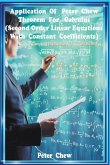The Peter Chew Method for Quadratic Equations is a simple and efficient approach for solving quadratic equations problem. Its objective is to make it easier for the upcoming generation to solve quadratic equations, including higher order function problems that cannot be solved by current methods. The French mathematician , Veda established the relationship between the equation root and the coefficient in 1615. Veda's theorem states that if a and ßare two roots of the quadratic equation ax2+bx+c=0 and a ≠ 0. Then the sum of the two roots, a+ß= -b/a , the product of the two roots, aß= c/a . The current method for solving quadratic equations involves finding the values of a +ßand aß using Veda's theorem, and then converting the problem given into the a+ßand aßforms, and then substituting the values of a+ßand aßto the problem given obtain the answer. However, this method is inadequate for solving higher order function quadratic equations , since it is difficult to convert them into a+ßand aß forms With the Peter Chew method, we can solve higher order function quadratic equations . without the need to convert them into a+ßand aßforms. Additionally, this approach is applicable to quadratic equations with complex roots and complex coefficients. The Peter Chew method involves finding the roots of the quadratic equation, denoting them as a and β, and then substituting these values to the problem given to find the answer.
![Education 4.0 Knowledge. Peter Chew Method For Quadratic Equation [2nd Edition] - Chew, Peter Education 4.0 Knowledge. Peter Chew Method For Quadratic Equation [2nd Edition] - Chew, Peter](https://bilder.buecher.de/produkte/67/67710/67710396n.jpg)

![Future Knowledge. Peter Chew Correction For Sine Rule [3rd edition] Future Knowledge. Peter Chew Correction For Sine Rule [3rd edition]](https://bilder.buecher.de/produkte/69/69710/69710217m.jpg)




